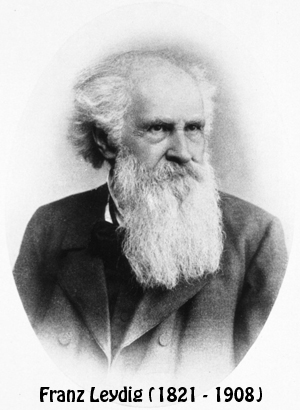 Franz Leydig
Franz Leydig
 Franz Leydig
Franz Leydig
(Q) The leydig gland is the same as that we have called the lyden, and is located in the gonads.
(A) It is in and above, or the activity passes through the gonads. Lyden is the meaning - or the seal, see? while Leydig is the name of the individual who indicated this was the activity. You can call it either of these that you want to. (Edgar Cayce reading 281-53)
 Since the Cayce readings linked the Leydig Gland with Professor Leydig, it is good idea idea to learn a bit about the man and what he discovered that may be relevant to the Cayce readings. Although Leydig is best known for his description of the testicular interstitial cells (cells of Leydig) in 1850, he produced more than 200 scientific publications during his career, including eight books. The cells of Leydig are definitely relevant to our quest and fortunately have been researched extensively with lots of information available that will be reviewed on this site.
Since the Cayce readings linked the Leydig Gland with Professor Leydig, it is good idea idea to learn a bit about the man and what he discovered that may be relevant to the Cayce readings. Although Leydig is best known for his description of the testicular interstitial cells (cells of Leydig) in 1850, he produced more than 200 scientific publications during his career, including eight books. The cells of Leydig are definitely relevant to our quest and fortunately have been researched extensively with lots of information available that will be reviewed on this site.
In 1857 Leydig moved to the University of Tubingen where he assumed the position of Professor of Zoology and Comparative Anatomy and then moved again in 1875 to the University of Bonn as Professor of Anatomy. Leydig retired when he was 66 years of age and returned to Wurzburg and Rothenburg ob der Tauber, where he died at 87 years of age.
It was during his retirement that he is credited with discovering the "Leydig gland" (in 1892), which may be relevant to some of the primary questions of this website (i.e, what is the Leydig/lyden gland, where is it, and what does it do?"). If you have any information on the discovery of the "Leydig gland," please contact me (David McMillin) via the Contact link in the top menu.
The online version of the Complete Dictionary of Scientific Biography contains a nice biography of Leydig with his major discoveries. The following reference to his discovery of the "Leydig Gland" may be helpful:
Leydig is also known for the discovery of the gland of Leydig (1892), a portion of the mesonephros in vertebrates, of which the secretions are thought to stimulate the movement of spermatozoa ... (Leydig, 2008, webpage)
Here is a link to the biography. A bibliography at the bottom of the page appears to contain references, hopefully documenting the above quote:
http://www.encyclopedia.com/doc/1G2-2830902604.html
The closest reference appears to be: "Besteht eine Beziehung zwischen Hautsinnesorganen und Haaren (1893)." It may be worth looking at more closely and can be found at:
As an overview, here is a list of Leydig's major works. If you are interested and can read German, you may notice something in the titles of these works that is potentially relevant to our research.
"Leydig, Franz von." Complete Dictionary of Scientific Biography. 2008. Retrieved May 30, 2013 from Encyclopedia.com: http://www.encyclopedia.com/doc/1G2-2830902604.html